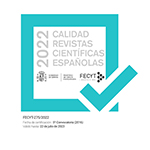The Orality-Literacy Continuum in Bicultural and Bilingual Environments: Galician and Traditional New Mexican Spanish
Abstract
In the Iberian Peninsula, Galician, a language spoken in Northwest Spain that, after reaching a high point of development as a written language in the Middle Ages, survived as a mostly oral language for centuries, finds itself today looking for a standard variety that would help it survive and define its own space between Portuguese and Castilian Spanish. In the United States, Traditional New Mexican Spanish (TNMS), a variety of Spanish associated with New Mexico and Southern Colorado and recognized as the oldest known variety of Spanish in the Americas, is about to disappear, or has already disappeared, immersed within different linguistic varieties and standard forms of Spanish and English. Both Galician and TNMS have historically gone through stages of literacy and orality. With the goal to examine the relationship between cultural and linguistic identity as it relates to the orality-literacy continuum, this article shares preliminary results of a research project in progress that includes a comparative look at the socio-linguistic situations of Galician in Spain and Traditional New Mexican Spanish in the US.Downloads
Article download
License
In order to support the global exchange of knowledge, the journal Madrygal. Revista de Estudios Gallegos is allowing unrestricted access to its content as from its publication in this electronic edition, and as such it is an open-access journal. The originals published in this journal are the property of the Complutense University of Madrid and any reproduction thereof in full or in part must cite the source. All content is distributed under a Creative Commons Attribution 4.0 use and distribution licence (CC BY 4.0). This circumstance must be expressly stated in these terms where necessary. You can view the summary and the complete legal text of the licence.








